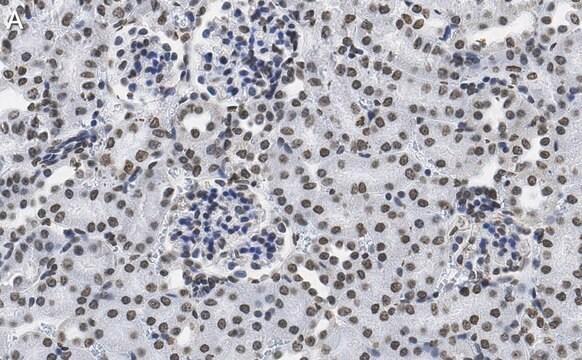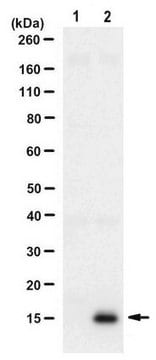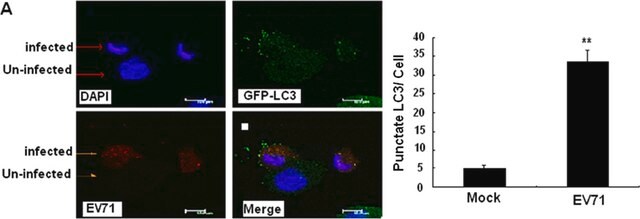MABE1126
Anti-DNA G-quadruplex (G4) Antibody, clone 1H6
clone 1H6, from mouse
Synonym(s):
DNA G-quadruplex (G4)
About This Item
Recommended Products
biological source
mouse
Quality Level
antibody form
purified immunoglobulin
antibody product type
primary antibodies
clone
1H6, monoclonal
species reactivity (predicted by homology)
all
technique(s)
ELISA: suitable
flow cytometry: suitable
immunocytochemistry: suitable
immunohistochemistry: suitable (paraffin)
isotype
IgG2bκ
shipped in
wet ice
target post-translational modification
unmodified
General description
Specificity
Immunogen
Application
Immunocytochemistry Analysis: A representative lot detected discrete DNA G-quadruplex (G4) foci on the compact chromosome in the metaphase HeLa and murine embryonic stem cells (Henderson, A., et al. (2014). Nucleic Acids Res. 42(2):860-869).
Immunocytochemistry Analysis: A representative lot detected greatly diminished nuclear DNA G-quadruplex (G4) immunoreactivity upon DNase treatment of paraformaldehyde-fixed and Triton X-100-permeablized HeLa cells (Henderson, A., et al. (2014). Nucleic Acids Res. 42(2):860-869).
Immunocytochemistry Analysis: A representative lot detected G-quadruplex (G4) stabilizing agent telomestatin/TMS treatment-induced nuclear DNA G4 immunoreactivity in chicken DT40 cells lacking the G4-unwinding helicase FANCJ, while the drug enhancing effect was not seen in human FANCJ-expressing DT40 cells (Henderson, A., et al. (2014). Nucleic Acids Res. 42(2):860-869).
Immunocytochemistry Analysis: A representative lot detected a time-dependent increase of nuclear DNA G-quadruplex (G4) foci in U20S cells following the treatment of the DNA G4-stabilizing agent telomestatin/TMS (Henderson, A., et al. (2014). Nucleic Acids Res. 42(2):860-869).
ELISA Analysis: Target selectivity of a representative lot was determined by competitive ELISA. Clone 1H6 binds both tetramolecular and unimolecular (intramolecular) DNA G-quadruplex (G4) structures (Henderson, A., et al. (2014). Nucleic Acids Res. 42(2):860-869).
Flow Cytometry Analysis: A representative lot detected enhanced DNA G-quadruplex (G4) immunoreactivity in HeLa cells upon treatment with the DNA G4-stabilizing agent TMPyP4, Cat. No. 613560 (Henderson, A., et al. (2014). Nucleic Acids Res. 42(2):860-869).
Immunohistochemistry Analysis: A representative lot detected nuclear DNA G-quadruplex (G4) immunoreactivity in various paraffin-embedded human tissue sections, including skin, pancreas, testis, placenta, brain, appendix, colon, and kidney (Henderson, A., et al. (2014). Nucleic Acids Res. 42(2):860-869).
Epigenetics & Nuclear Function
Nuclear Receptors
Quality
Immunocytochemistry Analysis: 2.0 µg/mL of this antibody detected DNA G-quadruplex (G4) in HeLa cells.
Physical form
Storage and Stability
Other Notes
Disclaimer
Not finding the right product?
Try our Product Selector Tool.
recommended
Storage Class Code
12 - Non Combustible Liquids
WGK
WGK 1
Flash Point(F)
Not applicable
Flash Point(C)
Not applicable
Certificates of Analysis (COA)
Search for Certificates of Analysis (COA) by entering the products Lot/Batch Number. Lot and Batch Numbers can be found on a product’s label following the words ‘Lot’ or ‘Batch’.
Already Own This Product?
Find documentation for the products that you have recently purchased in the Document Library.
Our team of scientists has experience in all areas of research including Life Science, Material Science, Chemical Synthesis, Chromatography, Analytical and many others.
Contact Technical Service






